Match format:
- Men singles, Women singles, Doubles and Mixed Doubles depending on number of participants.
- Open play. Open to all skill levels, both male and female players
- All players play matches in a round robin league. Each match is played for "4 boards or 30 minutes or 25 points", whichever is first.
- Top players move on to quarter finals, then semis, then finals.
- Official carrom rules will be observed - More details will be published soon.
Trophies for winner and Runner in each group.
- This is an amateur competition so we encourage players of all skill levels to participate
Game supplies will be provided like Carom Board, Coins, Strikers, Powders etc... unless anyone wants to bring his or her own tournament quality supplies.
Entry Fees: $5.00 for each entry. More details will be published very soon.
REGISTER NOW {We will contact you when ever there will be a tournament again}
Rules in place:
In these Laws, unless there is anything repugnant to the subject or context, the terms given below shall have the following interpretations:
1) Laws shall mean the Laws of Carrom.
2) a) ‘Proper’ shall mean in accordance with the Laws.
b) ‘Improper’ shall mean contrary to the Laws.
3) ‘C/B’ Shall mean Carrom Board
4) ‘C/m’ shall mean Carromman/ Carrommen.
5) ‘Board’ shall mean break to completion of pocketing the last C/m of any player.
6) ‘Break’ shall mean the first stroke of a board.
7) ‘Finish’ shall mean the completion of the board.
8) ‘Player’ shall mean a Carrom player
9) ‘Placing’ shall mean keeping the penalty and/or due C/m in a fiat position within the outer circle only by the player permitted to do so as per Laws. The Queen and/or jumped C/m shall always be placed by the umpire in the Centre Circle.
10) ‘Pocketing’ shall mean putting C/m and or Queen into the pocket by a proper/improper stroke.
11) ‘Push’ shall mean a jerk or sudden motion of the elbow of the playing ‘hand’ instead of striking the Striker with the tip of the finger.
12) ‘Queen’ shall mean the red C/m.
13) ‘Due’ shall mean pocketing the Striker with or without C/m~
14) ‘Penalty’ shall mean punishment for infringement or violation of Laws.
15) ‘Covering’ shall mean pocketing one of his own C/m by a player in the same or immediate subsequent stroke, when or after queen is pocketed~
16) Shot shall mean a pair or cannon.
a) ‘Pair’ shall mean placing a C/m within the Outer Circle near another. C/m and/or Queen in such a way that there is space and the existing C/m faces the general direction of a pocket.
b) ‘Cannon’ shall mean placing a C/m within the Outer Circle near another C/m and/or Queen in such a way that there is no space and the existing C/m faces the general direction of a pocket.
17) ‘Thumbing’ shall mean taking a stroke with the thumb.
18) ‘Turn’ shall mean the right to strike.
19) ‘Chief Referee’ shall mean an official appointed to administrate, supervise, control and give decisions on all matters referred to him in the course of a match.
20) ‘Umpire’ shall mean an official appointed to supervise and/or control a match.
21) a) ‘Opponent’ in singles shall mean the player presently not having his turn to play.
b) ‘Opponent’ in doubles shall mean the player sitting on the left and/or right side of the player presently having his turn to play.
22) ‘Hand’ shall mean the portion of the playing hand from the fingers up to the wrist.
23) ‘Finger’ shall mean the portion of the nail side of a finger up to the second joint.
24) ‘Imaginary Lines’ shall mean the lines drawn in extension of the arrows between the Base Circles.
25) ‘Stroke’ shall mean hitting the C/m by the Striker directly or indirectly.
26)a) ‘White Slam’ shall mean pocketing all the nine white C/m and the Queen as per Laws in the first turn of play. It may also be called ‘Break to Finish’.
b) ‘Black Slam’ shall mean pocketing all the remaining black C/m with or without Queen as per Laws in the first turn of play.
NOTE: Words implying singular shall include plural and words implying masculine shall refer to the feminine also. |
27) In singles, the players shall sit opposite site to each other.
28) In doubles, the partners shall sit opposite to each other, occupying all four sides.
29) Position adopted for sitting by a player before taking his turn to strike may be changed at any time provided the chair or stool on which he is sitting is not lifted, moved and/or disturbed during his turn of play.
30) a) During the board no part of the body of a player, except the playing arm shall touch the Carrom Board, stand or table on which the C/B is placed.
b) However, wearing/clothing, ring, bangles and/or watch worn by a player are exempted during his turn of play, but these should not touch the playing surface.
31) Use of any material to raise and/or adjust the height of the seat is permissible after the completion of the board only.
32) No part of the body, except the ‘hand’ of the player shall go beyond the imaginary lines of the arrows. |
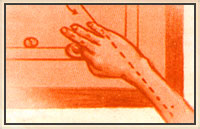
|
33) The Striker shall be struck and not pushed.
34) The stroke shall be made with the finger with or without the support of other fingers.
35) Any hand may be used' in play.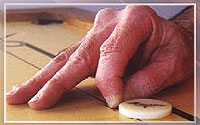
36) While taking the stroke, the 'hand' may touch the playing surface.
37) a) The elbow of the playing 'hand' shall not come within the playing surface nor shall extend beyond the imaginary lines of the arrow.
b) The 'hand' may, however, cross the arrow.
38) a) While making a stroke, taking support of the Stool or Chair, Stand or Table of the C/B and/or keeping the legs on the rim of the stand/table, by the player, is not permissible.
b) However, hands may rest on his body and legs may rest on the rim of the stool or chair, on which he sits.
39) a) There shall be a toss by the Umpire at the commencement of each match. The toss shall be by spin of coin or by means of calling the C/m. The player/pair winning the toss, shall have the choice of side or the option to strike first. Should the winner decide to have the choice of side, he shall indicate
same to the umpire, who shall instruct the loser to sit first.
b) In doubles, the pair winning the toss shall have the option as above.
c) If, however, break is chosen by the winner of the toss, the choice of side shall lie with the losers, and the winner shall have to sit first.
d) Once the losers have sat down, they cannot interchange. This order of sitting shall continue throughout the match.
40) There shall be two trial boards only after the toss and before the start of the match, one for each player or pair.
41) a) Before the break, the C/m are so arranged, in a flat position, that the Queen shall occupy the Centre Circle and the rest of the C/m are placed around the Queen in the first row keeping the Black and White C/m alternately. In the second row, three white C/m will form the shape "Y,' with the white C/m in the first row. The remaining space is filled up by placing black and white C/m alternately All C/m so arranged, should be in compact round, touching each other, within the Outer Circle. A player may use his fingers or striker to keep the C/m intact.
b) The C/m should be arranged for the break with least possible loss of time after each board.
42) Break is taken by a player who has chosen to strike first.
43) The player who is to break shall have the white C/m during that board leaving the black C/m to his opponent. The Queen shall be the common C/m.
44) Break is considered to have been made if the Striker touches any of the C/m even slightly.
45) a) Break is not considered to have been made if no C/m is touched by the Striker in its usual run or jumping out. In that case, a maximum of two more chances shall be allowed.
b) If after permissible number of chances, no C/m is touched, the right to Break shall be lost and the turn to play shall pass to the opponent who shall have black C/m for play but no re-arrange-merit of C/m already arranged, shall be permitted. The above condition will prevail till the break is affected.
c) If a player in his attempt to break, plays an improper stroke or pockets his striker without touching any of the C/m, he shall lose his turn. However, Due/penalty shall not be applicable.
46) The break shall be taken only after the Umpire calls 'Play' and the stroke shall be made within 15 seconds of such call. The play shall be deemed to have begun from the moment the Umpire calls 'Play'.
47) If the break is made before the Umpire calls 'Play', all the C/m and/or Queen pocketed shall be taken out for placing and an additional C/m penalty or Due shall be declared.
player shall lose his turn.
48) As long as a player pockets his own C/m and/or Queen in accordance with the Laws, his turn shall continue. Otherwise it shall pass on to the opponent.
49) a) i) In the first game the player who chooses to break the first board shall have the white C/m. The turn to break shall pass alternately during the game.
ii) In the second game the player who did not have the first turn to break shall have his turn first.
iii) In the third game, the turn to break passes on to the first player.
b) In Doubles, however, the turn passes on to the player sitting to the right hand side of the player who had his turn.
50) A player shall not take more than 15 seconds for making a stroke from the moment the C/m/Queen/Striker has come to rest and picked up by the opponent and/or after observing the time limit for placing the C/m and/or Queen and/or foregoing Due/penalty C/m, if any.
51) If the turn is availed by a player who plays out of turn, before the Umpire could control, the offending player shall lose the board by the number of C/m and Queen as are on the C/B. If the above remains unnoticed, till the next stroke is taken, the turn shall be allowed and the. next turn shall be as per Laws.
52) a) The player who completes pocketing all his C/m first wins the board.
b) The value/points are as follows:
i) Queen : 5 points up to and including 21 points.
ii) C/m: 1 point each.
53) a) The number of C/m of the opponent on the C/B shall be the points gained by that player in that board.
b) The player is entitled to be credited with the value of the Queen, only if he wins the board.
c) The player who loses the board is not credited with the value of the Queen, even if he has pocketed and covered the 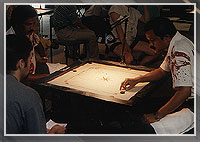 Queen.
Queen.
54) The player loses the advantage of getting the credit of an additional 3 points for covering the Queen, once he has reached the score of 22.
55) The maximum number of points that can be scored in a board is 12 only. Any Due and/or. penalty C/m shall automatically be written off.
56) a) A game shall be of 21 points or six boards. The player who reaches 21 points first or leads at the conclusion of the eight board shall be the winner of the game.
b) Up to and including the pre-quarter final rounds, each game shall be decided on the basis of eight boards. In case the score is equal at the end of the eighth board, an extra board shall be played to decide the winner. Before the extra board, there shall be a toss to choose break only.
57) All matches shall be decided by the best of three games only
58) In Singles, the change of side. by the players shall be made in the opposite direction at the conclusion of each game.
59) In Doubles, the change of sides by the players shall be made to the next right hand side, at the conclusion of each game.
a) From Quarter-Finals onwards the change of sides shall be made only after 11 points have been scored by any player/pair.
b) The change of sides, remaining unnoticed by the Umpire or any player, shall take place as and when noticed, but after completion of that particular board.
61) The players shall not take more than two minutes to change sides.
62) In general, any act of violation of Laws or anything done contrary to what is stated specifically or implied (as understood commonly) in these Laws, shall be broadly classified as:
A) Technical Foul
B) Foul
A. TECHNICAL FOUL
63) a) any act of violation of the Laws committed by the player before the first stroke of his turn shall be deemed as a Technical Foul. A Technical Foul shall entail one C/m of the offending player being brought out for placing by the opponent and his turn shall continue.
b) Any act of violation of the Laws committed by the player presently not having his turn shall also be deemed as a Technical Foul. A penalty shall be imposed as per Rule (a).
B. FOUL
64) a) any act of violation of the Laws committed by the player during or after the first stroke of his turn shall be deemed as Foul. A Foul shall entail one C/m of the offending player being brought out for placing by the opponent and the turn to play shall be lost.
b) While pocketing the C/m and/or Queen, if a Foul is committed, the number of C/m and/or Queen so pocketed with an additional C/m shall be brought out for placing and the turn of the player shall be lost.
65) a) If a C/m and/or Queen jump out of the playing surface, the jumped C/m and/or the Queen shall be placed by the Umpire in the Centre Circle, if space permits, covering it fully or the maximum portion of it that is available.
b) If both the Queen and a C/m jump In the same stroke preference shall be given to place the Queen first, and the jumped C/m shall be placed, touching the Queen, in the opposite direction of the player presently having his turn..
c) If both White and Black C/m jump in the same stroke, preference shall be given to place the C/m of the player who made that stroke first and the other C/m shall be placed, touching the first C/m in the manner described in Rule 65(b)
d) If more than 2 C/m jump in the same stroke, the placing of the first 2 C/m shall be in accordance with Rule 65(b) and Rule 65(c). The rest of the C/m shall be placed, touching the first 2 C/m, as far as possible.
66) a) If C/m and/or Queen jump out and fall back on the playing surface, the C/m and/or Queen shall be placed by the Umpire in the Centre Circle as per Laws. The position of the disturbed C/m, if any, shall be corrected by the Umpire, as far as possible, at his discretion.
b) If, however, C/m and/or Queen jump out and fall back on the playing surface after hitting the shade, bulb or light fittings, shall be considered to have naturally travelled. Disturbed C/m, if any, shall not be rearranged.
XIII. C/m ROLLING AND OVERLAPPING |
67) If C/m and/or Queen stand on its rim, it shall be allowed to remain as it is.
68) If two C/m and/or Queen overlap each other, they shall be left undisturbed.
69) a) If the Striker rests on C/m and/or Queen, the Striker shall be removed without disturbance to the C/m and/or Queen by the Umpire. If disturbed, the original position of the C/m and/or Queen shall be restored, as far as possible, by the Umpire.
b) If this happens at the mouth of the pocket and in the process of removal of the Striker the C/m and/or Queen lose its centre of gravity and fall into the pocket, they shall be deemed to have been pocketed.
70) a) If C/m and/or Queen rest on the striker, the Striker shall be removed by the Umpire by lifting~ the C/m and/or queen and replacing them, as far as possible, in the position where they would rest if the Striker was not there.
b) If, however, this happens at the mouth of the pocket and it the process of removal of the C/m and/or Queen, the Striker loses its centre of gravity and falls into the pocket, it shall be deemed to have been pocketed. A penalty shall be declared to be imposed as per Laws.
71) If a C/m resting perilously at the mouth of the pocket and actually falls into the pocket for any reason, it shall be considered to have been properly pocketed.
XIV. DUES AND/OR PENALTIES |
72) a) If in a proper stroke a player pockets his Striker alone, his turn shall be lost and one of his C/m will be taken out as penalty by his opponent for placing. Such penalty C/m shall be called Due.
b) If this happens before any of his C/m is pocketed the penalty Due shall remain outstanding and shall be taken out as soon as it is available.
73) If a player pockets the Striker with his own C/m, the number of C/m so pocketed, with a Due C/m, shall be taken out for placing and the player shall continue his turn.
74) If a player pockets the Striker with the C/m of his opponent, the C/m shall be deemed to have been pocketed. The Due as per Rule 72(a) shall be taken out for placing and the player shall lose his turn.
75) If a player pockets the Striker with C/m of his own and of his opponent, the number of his own C/m so pocketed, with a due C/m shall be taken out for placing by the opponent and the player shall continue his turn.
76) If a player pockets the C/m of his opponent by an improper stroke, the C/m so pocketed shall be deemed to have been pocketed. The Due shall be taken out for placing by the opponent and the player shall lose his turn.
77) a) If a player pockets his own C/m by improper stroke, the C/m so pocketed with a Due C/m shall be taken out for placing by the opponent and the player shall lose his turn.
b) If a player pockets his own C/m with the striker by an improper stroke, the C/m so pocketed with a Due shall be taken out for placing by the opponent and the player shall lose his turn.
78) a) Due or penalty C/m shall be taken out for placing immediately after being available, but only after the completion of the stroke, though it may be during the turn of the same player.
b) i) In Doubles the Due and/or penalty C/m shall always be taken out for placing by the player who is sitting on the right hand side of the player having his turn at the time of availability of C/m.
ii) If, however, during the turn of a player, he pockets the C/m of the opponent with or without his C/m and the Due and/or penalty C/m becomes available, the player himself shall takeout the C/m for placing.
79) a) If Due and/or penalty C/m is available for placing but sufficient space is not available, the player who has to place the C/m shall be permitted to do so immediately after space becomes available.
b) In Doubles, however, if the eligibility to place the Due and/or penalty C/m, has passed on to the partner, the partner alone shall have the right to take out and place the C/m.
80) If space is available for placing the Due and/or penalty C/m, but the player who has to place the C/m not desire to risk a Foul, he shall lose his chance to place and his claim for placing shall stand forfeited.
81) If the space becomes available for placing the Due and/or penalty C/m during the turn of the player, eligible to place, the placing shall be made immediately.
82) a) While placing the Due and/or penalty C/m, if a player places his own C/m by mistake, it has to be rectified if pointed out by the umpire or the opponent. A Foul shall be declared as per Laws.
b) If not noticed either by the umpire or the opponent before the next stroke is made, the C/m so placed shall be regarded as valid.
83) If more than one C/m are to be placed by a player as Due and/or penalty, the C/m available shall be placed immediately and rest of the C/m have to be placed as soon as available.
84) a) Placing shall be considered as complete once the finger is removed from the C/m provided the C/m placed is inside the Outer Circle.
b) However, while placing Duel penalty C/m holding of any other C/m and/or striker is not permitted.
85) If a player places or moves the Due and/or penalty C/m away from the Outer Circle, he shall he asked to place the C/m inside the Outer Circle. A Foul shall be declared as per Laws.
86) While placing the Due and/or penalty C/m the player should not move any other C/m and/or Queen. The C/m so placed shall not disturb any other C/m. If it so happens, the same shall be replaced by the Umpire in the original position, as far as possible. A Foul shall be declared against the offending player as per Laws.
87) A player may choose to forego the Due and/or penalty C/m in toto only and not partially. Such decision shall be communicated to the Umpire within 15 seconds, failing which the right to place the Due and/or C/m shall be forfeited.
88) The time limit for placing Due and/or penalty C/m shall be 15 seconds after the announcement made by the Umpire.
89) a) Due and/or penalty C/m cannot be set off against each other.
b) Due and/or penalty C/m shall not be placed covering the Centre Circle wholly or partially. If placed, the player shall be asked to rectify. A Foul shall be declared against the offending player as per Laws.
90) In Doubles, a player shall not take out the penalty and/or Due C/m for his partner, who has to place it. In case his partner does not find the required C/m in the pockets adjoining his side, he shall request the Umpire to provide, specifying the color and number of C/m he needs for placing.
91) During the course of the Board, if a player gets up from the seat during his turn or of his opponent’s turn, for any reason, he shall lose the Board with the number of his C/m and/or Queen lying on the Board. If the score of the opponent is 22 or more he shall lose the Board by the number of C/m only.
92) A player has the right to pocket the Queen and to cover it provided a C/m of his own has already been pocketed.
93) The Queen shall be placed by the Umpire only in the Centre Circle. While placing so, however, if shot is automatically formed, it cannot be altered.
94) a) If the Centre Circle is partially or completely covered by other C/m, the Queen shall be placed so as to occupy most of the 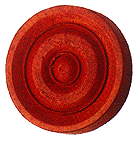 uncovered portion or in any position adjacent to the Centre Circle in such a way so that it is not easy to pocket for the player having his turn. The placing of the Queen by the Umpire, in such a situation, shall be final.
uncovered portion or in any position adjacent to the Centre Circle in such a way so that it is not easy to pocket for the player having his turn. The placing of the Queen by the Umpire, in such a situation, shall be final.
95) a) If the Queen is pocketed before any C/m of the player is pocketed, the Queen shall be taken out for placing and the player shall lose his turn.
b) If a player pockets the Queen, while there is a Due against him, the Queen shall be taken out for placing and the player shall lose his turn.
c) However, if after recovery of Due and/or penalty, all the nine C/m are on the C/B, a player shall have the right to pocket the Queen and to cover it.
d) If, at the break or in a subsequent stroke when all his nine C/m are on the C/B, the Queen is pocketed along with the Striker, the Queen shall be taken out for placing and a Due shall be declared. The player shall lose his turn.
96) If the Queen is pocketed by a stroke and is not covered, the Queen shall be taken out for placing. If not noticed by the Umpire or by the opponent, before the next stroke is made, the Queen shall be recorded as properly covered.
97) a) If the Queen and the C/m of a player are pocketed together in one stroke, the Queen shall be considered covered.
b) However, at the Break and/or in any subsequent stroke, when all 9 C/m of the player are on the C/B, if the Queen and one of the C/m are pocketed together, the Queen has to be covered. If more than one C/m and the Queen is pocketed together, the Queen shall be considered covered.
98) a) If the Queen, C/m and the Striker are pocketed together by a proper stroke the Queen and the C/m so pocketed with an additional one as Due, shall be taken out for placing and player shall continue his turn.
b) If the Queen, C/m and Striker are pocketed together by an improper stroke, Queen and the C/m so pocketed with two additional C/m as due shall be taken out for placing and the player shall lose his turn.
99) a) If the Queen and the Striker are pocketed together by a proper stroke, the Queen shall be taken out for placing by the Umpire. An additional C/m shall be taken out for placing by the opponent and the player shall continue his turn.
b) If the Queen and the Striker are pocketed together by an improper stroke, the Queen shall be taken out by the Umpire for placing. Two additional C/m shall ~be taken out for placing by the opponent and the player shall lose his turn.
100) a) While covering the Queen, if the Striker alone is pocketed, the Queen shall be taken out placing. A C/m of the offending player shall be taken out as Due for placing by the opponent and the player shall lose his turn.
b) While covering the Queen, if the Striker alone is pocketed, by an improper stroke the Queen shall be taken out for placing. Two C/m of the offending player shall be taken out as Due for placing by the opponent and the player shall lose his turn.
101) a) While covering the Queen, if a player pockets the striker along with his C/m, the C/m so pocketed plus one C/m as Due shall be taken out for placing by the opponent. The player shall however, continue his turn. If in the subsequent stroke no C/m of the player is pocketed, the Queen shall not be considered to have been covered and it shall be taken out for placing.
b) While covering the Queen, if a player pockets his Striker along with his C/m by an improper stroke, the C/m so pocketed plus two C/m as due shall be taken out for placing by the opponent and the player shall lose his turn.
102) a)While covering the Queen a player pockets the last C/m of his own together with the last C/m of the opponent, he shall be awarded 3 points. If the score is 22 or more he shall win by I point.
b) While covering the Queen, a player pockets the last C/m of his own together with the last C/m of his opponent by an improper stroke the opponent shall win by three points, if the score is 22 or more he shall win by one point. if demanded, an additional point for the improper stroke shall be awarded to the opponent.
103) a) While covering the Queen, if a player pockets the last C/m of his opponent, he shall lose the Board by the number of his C/m lying on the C/B together with the points for the Queen. If the score of the opponent is 22 or more, he shall lose by the number of C/m only.
b) While covering the Queen, if a player pockets the last C/m of his opponent by an improper stroke, he shall lose the Board by the number of his C/m lying on the C/B together with the points for the Queen. If the score of the opponent is 22 or more, he shall lose by the number of C/m only. if demanded, an additional point shall be awarded to the opponent.
104) a)If a player pockets the Queen along with his last C/m and the last C/m of the opponent by a proper stroke, the player shall win the Board by 3 points. If the score is 22 or more he shall win by I point.
b) If a player pockets the Queen along with his last C/m and the last C/m of the opponent by an improper stroke, the opponent shall win the board by 3 points. If the score is 22 or more he shall lose by I point. If demanded one additional point shall be awarded.
105) a) If a player pockets the last C/m of his own and of the opponent by a proper stroke while the Queen is on the C/B, the opponent shall be awarded 3 points. If the score is 22 or more he shall be awarded only I point.
b)If a player pockets the last C/m of his own and of his opponent by an improper stroke while the Queen is on the C/B, the opponent shall be awarded 3 points. If the score is 22 or more he shall be awarded only I point. If demanded the opponent shall be awarded I additional point.
106) a) If a player by a proper stroke pockets the last C/m of the opponent when the Queen is on the C/B, he shall lose the Board by the number of his own C/m lying on the
C/B together with the points for the Queen. If the opponent’s score is 22 or more he shall lose by the number of C/m only.
b)If a player pockets the last C/m of the opponent by an improper stroke when the Queen is on the C/B, he shall lose the Board by the number~ of his own C/m lying on the C/B together with the points for the Queen. If the opponent score Is 22 or more he shall lose the Board by number of C/m only. If demanded, the opponent shall be awarded one point in addition.
107) a)If a player pockets his last C/m by a proper stroke leaving the Queen on the C/B, he shall lose the Board by 3 points. If the opponent’s score is 22 or more he shall lose by one point.
b) If a player pockets his last C/m by an improper stroke leaving the Queen on the C/B, he shall lose the Board by 3 points. If the opponent’s score is 22 or more he shall lose by one point. If demanded, the opponent shall be awarded one additional point.
108) a) If a player pockets his last C/m along with the Striker leaving the Queen on the C/B, by a proper stroke, he shall lose the Board by 3 points. If the score of the opponent is 22 or more, he shall lose by one point One additional point shall be awarded if demanded by the opponent
b) If a player pockets his last C/m along with the Striker leaving the Queen on the C/B by an improper stroke, he shall lose the Board by 3 points. If the score of the opponent is 22 more, he shall lose by one point. If demanded the opponent shall be awarded two additional points.
109) a) If a player pockets the Queen, his last C/m, the last C/m of his opponent by a proper stroke together with the Striker the player shall lose the Board by 3 points. If the score of the opponent is 22 or more, he shall lose by one point. One additional point shall he awarded if demanded by the opponent.
b) If a player pockets the Queen, his last C/m, the last C/m of his opponent together with the Striker by an improper stroke, the player shall lose the Board by 3 points. If the score of the opponent is 22 or more, he shall lose by one point. If demanded, the opponent shall he awarded two additional points.
110) a) If a player pockets the last C/m of his own and of his opponent together with the Striker by a proper stroke he shall lose the Board by one point, if the Queen has been covered by him. One additional point for the pocketed Striker shall be given if demanded by the opponent.
b) If a player pockets the last C/m of his own and of his opponent together with the Striker by an improper stroke, he shall lose the Board by one point, if the Queen has been covered by him. Two additional points shall be awarded if demanded by the opponent.
111) a) If a player pockets the last C/m of his opponent along with the Striker leaving the Queen on the C/B by a proper stroke, he shall lose the Board by the number of his C/m lying on the Board plus the value of the Queen. If the score is 22 or more, he shall lose by the number of C/m only. One additional point for the pocketed Striker shall be awarded if demanded by the opponent.
b) If a player pockets the last C/m of his opponent along with the Striker leaving the Queen on the C/B by an improper stroke he shall lose the Board by the number of his C/m lying on the Board plus the value of the Queen. If the score is 22 or more he shall lose by number of his C/m only. If demanded, the opponent shall be awarded two additional. points.
112) a) If a player pockets the last C/m of his own and of his opponent together with the Striker by a proper stroke, he shall lose the Board by 3 points, if the Queen has been covered by the opponent. One additional point shall be awarded if demanded by the opponent.
b) If a player pockets the last C/m of his own and of his opponent together with the Striker by an improper stroke he shall lose the Board by 3 points, if the Queen has been covered by the opponent. Two additional points shall be awarded if demanded by the opponent.
113) If the Queen resting perilously at the mouth of the pocket and actually falls into the pocket for any reason, it shall be considered to have been (duly) pocketed.
114) A player shall not utilize the Due and/or penalty C/m to make a shot with the Queen. If utilized, he shall be asked by the Umpire to rectify. A Foul shall be declared as per Laws.
115) A stroke shall be taken by means of a Striker only. The Striker shall be brought by the player and certified by the Chief Referee/Umpire before play.
116) While taking a stroke, if the Striker jumps over the C/B, the turn of the player shall continue if he pockets his own C/m and/or Queen in that stroke.
117) A changed new Striker, duly approved by the Chief Referee/Umpire, shall be allowed in a match, after the particular board is completed. However, if in the middle of the board, the Striker is broken, it is permitted to change the same only after completion of that particular stroke.
118) a) Once set, the position of the C/B shall not be changed in the middle of the match.
b) However, the sole authority to make any change after examination, on appeal by any player, lies with the Umpire.
119) The C/B, table or stand on which, the C/B is placed, allotted for a match can be changed only after the completion of a Board. The sole authority for deciding the condition of the C/B, Table or Stand rests with the Umpire.
120) Any broken C/m, if appealed for replacement, shall be replaced by the Umpire in the original position of the broken C/m as far as possible.
121) a) The time count stops when there is an appeal to the Umpire by a player, during the play. The play shall not continue unless the Umpire has ordered ‘Play’.
b) The player who violates shall lose the entire board with the number of his C/m lying on the C/B with the points of the Queen, as per Laws, if it is lying on the C/B.
122) a) The powder shall be applied evenly, by the player having the turn, over the playing surface before break. The use of powder shall be neither excessive nor scanty.
b) i) The powder shall not be applied or removed after the Umpire has announced ‘Play’.
ii) Any willful attempt to remove or wipe powder from the playing surface shall not be permitted.
iii) The removal of powder from the playing surface by way of blowing, wiping or any other way shall not be permitted.
For any infringement, as stated above in 122(b) (i), (ii) & (iii) a Foul shall be declared against the offending player as per Laws.
c) However, along the Base Lines and Base Circles of his side, excess powder, if any, may be removed with the help of the Striker only, by a player during his turn of play.
d) The Umpire shall have the right to control the even application of powder on the playing surface.
e) The Umpire should be requested for removal of dust, insects, etc., from the C/B during the course of play.
123) A stroke is considered complete only after the Striker, C/m and/or Queen disturbed by the Striker comes to rest. The Striker shall be removed by the-player from the C/B immediately after the stroke is completed. The Umpire may assist on request.
124) a) as long as a player pockets his own C/m and/or Queen, the time count starts as soon as the stroke is complete.
b) However, in a stroke, when a player fails to pocket his C/m and/or Queen, the time count for the opponent shall start only after the Striker has been removed from the C/B.
c) A player shall not make the stroke before the opponent picks up his Striker from the C/B.
125) a)When a player pockets the C/m of his opponent knowingly or unknowingly, the Umpire shall stop the player from playing further.
b) If unnoticed by the Umpire or by the opponent, the C/m pocketed shall be considered to have been properly pocketed. The turn of the player shall be lost as and when noticed.
126) a) The player shall not hit, tap or disturb the C/B willfully or otherwise. If done, a Foul shall be declared against the offending player as per Laws.
b) However, if it is done by the player/s in such a way that rearrangement of the C/m becomes impossible, he shall lose the entire board with the number of C/m lying on the C/B with the points for the Queen as per Laws.
127) a)A stroke shall be considered to have been made, if the Striker slips, leaving any Base Line or Base Circle, irrespective of whether it has touched any C/m or not.
b) However, if the Striker slips and does not leave any Base Line or Base Circle or moves any C/m, stroke shall not be considered to have been made.
128) A player may find out the score from the Umpire only during his turn of play.
129) A player shall not distract the attention of the opponent by any act.
130) a) While taking a stroke, the Striker must touch both the Base Lines.
b) If the Striker is made from the Base Circle, the Striker must cover the Base Circle fully, but shall not touch the arrow.
131)In doubles, during the course of a Board, the partners are not allowed to talk or communicate with each other by gestures. Any 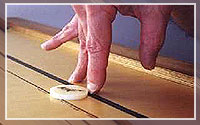 violation in this regard shall be penalized with a Foul as per Laws.
violation in this regard shall be penalized with a Foul as per Laws.
132) Players shall not talk to the spectators during the course of a game without the permission of the Umpire.
133) The play& shall not hold any solid material, except the Striker in either hand during the course of his turn.
134) The C/m and/or Queen shall not be moved or disturbed after the Break, except by way of a stroke. If touched, moved or disturbed the same shall be replaced in the original position by the Umpire, as far as possible and a Foul shall be declared against the offending player as per Laws.
135) The run of the Striker shall not be tested on the playing surface during the course of a Board.
136) a)The player shall not keep his Striker on the frame or in the pocket of the C/B during the board.
b) However, the player shall be per mitted to place the Striker and/or C/m on the playing surface, near his base line only, while placing the Due and/or penalty C/m.
137)If the players pass over their turn consecutively for 3 times each, that particular Board shall be cancelled and be replayed.
138)A player is permitted to concede a game and/or match at any stage.
140)In case of any unforeseen circumstances beyond the control of umpire who feels that rearrangement of the C/m is not possible, that particular Board shall be replayed.
141)If a C/m is broken by a stroke during the course of the Board, the position of the bigger part of the broken C/m is considered for all purposes and the Umpire decision shall be final.
142)In the event of the C/m lying on the Base lines/Base Circles, preventing the player from taking a stroke for want of space for placement of his Striker, that board shall be replayed.
XVII. LOSS OF ENTIRE MATCH |
143) A player shall be liable to lose the entire match for any act of indiscipline and/or breach of any of the Law and/or any of the following.
a) Fails to report to the Umpire at his/her match Board within 15 minutes after the match is announced.
b) Fails to abide by the time limit given for the rest in the deciding game during a match.
c) Refuse to abide by the decision of the Umpire and/or Chief Referee.
d) Passes insulting remarks against the Umpire, Chief Referee and/or authorities before or during, or immediately after the match.
e) Smokes or smells Foul while at play due to intoxicating drinks and/or is under the influence of drugs.
f) Plays with an uncertified Striker.
g) Discontinues play during the course or a match, without the permission of the Umpire.
h) Disturbs and distracts the attention of the opponent while at play more that twice, despite Umpire’s warning.
i) Leaves the match Board area during the game without the permission of the Umpire.

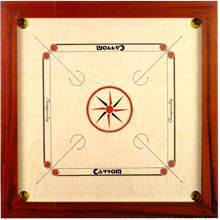
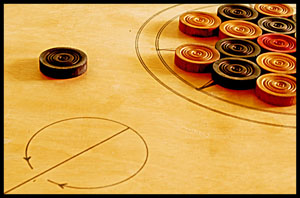


 Queen.
Queen.  uncovered portion or in any position adjacent to the Centre Circle in such a way so that it is not easy to pocket for the player having his turn. The placing of the Queen by the Umpire, in such a situation, shall be final.
uncovered portion or in any position adjacent to the Centre Circle in such a way so that it is not easy to pocket for the player having his turn. The placing of the Queen by the Umpire, in such a situation, shall be final. violation in this regard shall be penalized with a Foul as per Laws.
violation in this regard shall be penalized with a Foul as per Laws.